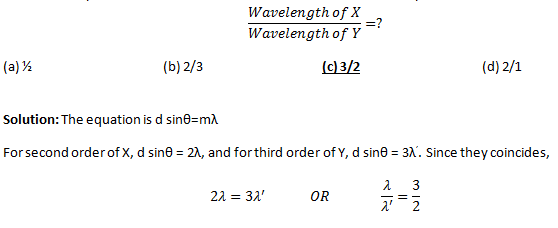Question: Choose the correct answer of the following questions.
1. Which one of the following properties of light does not change when it enters from one medium to another medium?
| (a) Frequency | (b) Wavelength | (c) Velocity | (d) Amplitude |
Explanation: Frequency of light actually depends on the source which radiates it. It does not depend on the medium in which it is traveling. The speed changes when light enters from one medium to another due to the different refractive index. However, the change in speed or velocity of light is due to the change in the wavelength of the light. The frequency remains unchanged.
2. The principle of Young’s double slit experiment is based on the division of,
| (a) Amplitude | (b) Frequency | (c) Velocity | (d) Wavelength |
Explanation: The two slits divide the same wave front creating two coherent wavelengths which interfere with one another making alternate maxima and minima on the screen.
3. Which one of the following properties proves the transverse wave nature of light?
| (a) Interference | (b) Refraction | (c) Polarization | (d) Diffraction |
Explanation: The confinement of numerous electric and magnetic fields of light in numerous directions to one plane is called polarization of light. If light was longitudinal wave it couldn’t be polarized.
4. Colored fringes observed in soap bubble are the example of,
| (a) Diffraction | (b) Interference | (c) Polarization | (d) Reflection |
Explanation: Light consists of seven wavelengths. On diffraction on the surfaces of soap bubble, different wavelengths are diffracted at different angles. So when they interfere with one another, the result is not a white color but some else. Thus we see colored fringes.
5. During a sunny day we see the objects in a class room even when all the electric lights are off due to,
| (a) Reflection of light | (b) Refraction of light | (c) Diffraction of light | (d) Interference of light |
Explanation: By diffraction, light is spread out around the corners of different slits and inlets in the room. Therefore, the objects in the classroom become visible.
6. The principle of Michelson’s interferometer is based on the division of
| (a) Wavefront | (b) Amplitude | (c) Frequency | (d) Speed of light |
Explanation: In the Michelson’s interferometer, the amplitude of the incident ray is partially reflected and partially transmitted at the boundary of the mediums. Thus the principle used is the division of amplitude. See comprehensive for details.
7. In the Young’s double slit experiment the separation between the slits is halved and distance between slits and the screen is doubled. The fringe width is
| (a) Halved | (b) Unchanged | (c) doubled | (d) Quadrupled |
Solution: Fringe width is Fringe spacing between two consecutive maxima or consecutive minima. Therefore,
Fringe width = Fringe spacing = λL/d. Here L is distance between slit and screen and d is the separation between slits. (See comprehensive for details).
Now in the given case, separations in the slits are d and d/2. Similarly, the distances between the slits and screen are L and 2L. So the first case, fringe width is simply = λL/d … (1)
In the second case when L and d are changed,

Compare with equation (1) and find the proof.
8. Signal from a remote control to the device operated by it travels with the speed of
| (a) Sound | (b) Light | (c) Ultrasonic | (d) Supersonic |
Hint: Signals from a remote control are electromagnetic in nature.
9. Light of wavelength λ is incident normally on a diffraction grating for which the slit spacing is equal to 3λ. What is the sine of the angle between the second order maximum and normal?
| (a) 1/6 | (b) 1/3 | (c) 2/3 | (d)1 |

10. Which of the following gives three regions of the electromagnetic spectrum in order of increasing of wavelength visible radiation?
| (a) Gamma rays, microwaves, visible radiation | (b) Radio waves, ultraviolet , X-rays | (c) Ultraviolet, infrared, microwave | (d) Visible radiation, gamma rays, radio waves |
11.
Two monochromatic radiations X and Y are incident normally on diffraction
grating. The second order intensity maximum for X coincides with the third
order intensity maximum for Y. What is the ratio

12. The tip of a needle doesn’t give a sharp image. It is due to
| (a) Polarization | (b) Interference | (c) Diffraction | (d) Refraction |
Tip: We know diffraction is the bending of light around a sharp object.

Pingback:Numerical Problem 9, Physical Optics – msa
Pingback:Numerical Problem 1, Physical Optics, Physics 11 – msa